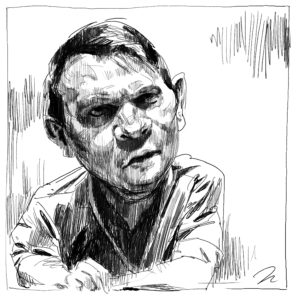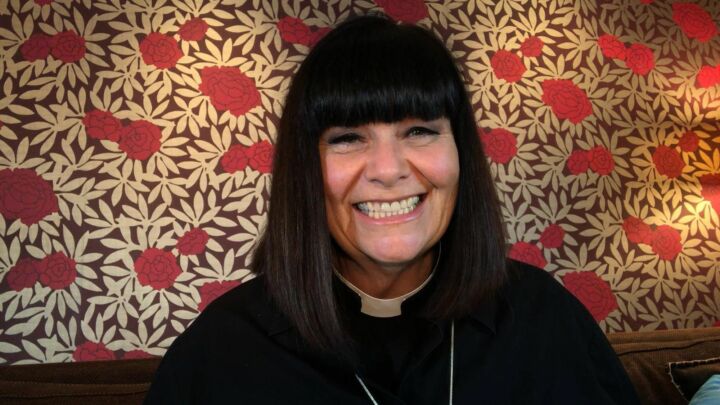‘MY PAIN’, by the Duchess of Pork
Celebrity therapist Pamela Connolly turns psychoanalysis into light entertainment on Channel 4's Shrink Rap. This week: Fergie.

The set-up of Channel 4’s Shrink Rap is simple. Over the course of six separate one-hour therapy sessions, well-known public figures, from former home secretary David Blunkett to the Duchess of York, Sarah Ferguson, are enthusiastically analysed by Dr Pamela Connolly. To a greater extent than antecedents, such as BBC Radio 4’s In the Psychiatrist’s Chair, Shrink Rap treads an uneasy path. For while it might pose as a therapy session, rich in insight into its participants’ private lives, broadcasting transforms it: it becomes a part of public life. And as such, it does at least capture something of the latter’s degradation.
Dr Connolly, wife of Billy, and former star of satirical sketch show Not the Nine O’Clock News, is instantly recognisable, but changed somehow. It soon makes sense. Sporting licks of blonde atop wrinkleless bronze, Dr Connolly is now as Californian as they come. But her impetus is less particular than her appearance. For as she argued in her doctoral thesis, and endorses in Shrink Rap, there is a strong relation between fame and trauma. In other words, the ‘cluster of personality types’ who strive for some form of public recognition do so because of some private, usually childhood, trauma (1).
The session with Sarah ‘Fergie’ Ferguson aka ‘the Duchess of Pork’, as she herself stoically recalled, was typical. Her parents, particularly her mother, failed, so she suggests, to provide the warmth and affirmation she craved. Their sins were no less for being unintended. When responding to questions as to why Fergie – big-boned and orange – looked different to the rest of the family, her mother would respond that she was the ‘postman’s’. ‘They were very quick and she was a great wit. But,’ Fergie continued, to Connolly’s nodded approval, ‘they didn’t realise the ramifications of their words…’ They should, perhaps, have stepped a little more gingerly around the muscular carrot-top.
There was more where that came from, as there usually is when your childhood is taking the fall for all future actions. Aged 12, young Fergie had ridden into town to get her hair cut. Upon returning, however, she discovered her mother had left – to live in Argentina with another man. Putting two and two together, she became convinced that her haircut was responsible for her mother absconding – a bad wet-look perm by anyone’s standards. Wracked by guilt and rejection, food became her sole comfort. Or as she put it: ‘I started eating my feelings.’ Which certainly explains the verbal diarrhoea.
Connolly goes on to argue that Fergie’s public travails – her attempt to be what the media wanted or to win the approval of the Royal Family – were public re-enactments of her childhood neglect, that is, a lack of kind words and a surfeit of barbs. Here, failure to win over either the Royal Family or the media was, as Connolly puts it, re-traumatisation. ‘Eighty-two per cent of men would prefer to sleep with a goat than Fergie’, as the Sun headline put it, might as well have been a parental put-down. She ‘was flipped back to a place of trauma.’
Within the therapy-speak, what’s disturbing is the ease with which Connolly grasps public life, indeed, one’s public persona, as a manifestation of inner maladjustment. Fergie’s adult life and public role as the Duchess of York merely embody the pattern of behaviour established in her childhood. Public life is reinterpreted as merely a chance to resurrect private trauma and master it, an opportunity to overcome some past rejection or loss. To not recognise it as such, according to Connolly, is to succumb to something like the former’s inauthenticity, to mistake one’s public persona for one’s true self rather than its echo. In this regard, an exchange at the end of the Fergie session is revealing:
Connolly: ‘When I think about fame, I sort of think about the emergence of another part of the self… The part of you that’s this idealised Sarah, this one who is the glamour puss, this one who has those beautiful photographs on the front of a magazine – I’m not letting it pass unnoticed that even now you refuse to accept that there are very beautiful photographs of you and that you are beautiful – sometimes that part of the self viewed by the true self, the real Sarah – and in your case, possibly the young Sarah – sometimes that true part self will have some feelings about that idealised self.’
Fergie: ‘That’s very interesting. You’re talking about the outside personality, which has to get on and be out there in public life, and the inner personality, and could the two mix.’
Connolly: ‘Well yes, I think it’s very painful if those two parts don’t connect’
What Shrink Rap exploits, albeit unconsciously, is the anxiety that currently infuses public existence. Public roles and responsibilities, bereft of the social narratives through which they were previously understood, are deprived of a point beyond themselves. The vocabulary of public life in this, the era of its privatisation, be it ‘celebrity’ or ‘fame’, reflects this vacuity. ‘Celebrity’ and ‘fame’, which were once a by-product of public life, have become its aims. Connolly’s sense that the life one leads in public is inauthentic, that is, ‘(fame’s) accompanying sense of worthlessness’, contains, in this respect, a grain of truth (2). But she goes further. She assumes its emptiness to be intrinsic to public existence per se. The only way to understand, to make sense of public life, then, lies in grasping the inner motivations of its individual participants. Following this logic through, the more driven, the more crazy.
And this, actually, is where Shrink Rap becomes most interesting. For all their unsavoury willingness to expose certain aspects of themselves, the analysands were not entirely willing to play along with the analyst, not wholly content to see their public lives reduced to post-traumatic coping mechanisms. With typically sly ingenuity, TV critic Nancy Banks-Smith captures well David Blunkett’s refusal to accept Connolly’s conflation of public and private: ‘She wanted to talk about his inner feelings. He wanted to talk about industrial compensation. They proceeded on perfectly parallel lines.’ (3)
Stephen Fry was just as recalcitrant – surprisingly, given past form. When being quizzed as to how he felt about being buggered as a schoolboy, he replied, ‘I’m happy to be of service.’ Connolly proceeded to admonish him for his refusal to give himself up: ‘I wish I could find it funny, Stephen, but I can’t.’ I disagree. Silence, or evasion in Fry’s case, is definitely the better part of valour. Better still though would be to resist such incontinence of the private sphere in the first place. There is something to be said here, if not for the dignity of repression, then certainly for self-control.
Tim Black is a regular film and TV reviewer for spiked
Read on:
spiked issue: TV
(1) Palace was a bleak house, Observer, 1 April 2007
(2) Honey I shrink the Stars, Guardian, 31 March 2007
(3) Last night’s TV, Guardian, Nancy Banks-Smith 5 April 2007
To enquire about republishing spiked’s content, a right to reply or to request a correction, please contact the managing editor, Viv Regan.








Comments
Want to join the conversation?
Only spiked supporters and patrons, who donate regularly to us, can comment on our articles.